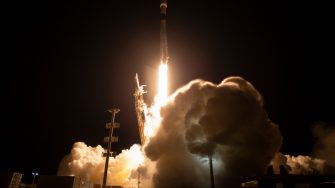Surface Water and Ocean Topography (SWOT)
Following the world’s ocean currents from space.
Following the world’s ocean currents from space.

In 2022, NASA and the French space agency CNES launched a satellite as part of the $1.5 billion Surface Water and Ocean Topography (SWOT) mission. The aim of the mission is to observe nearly all of Earth’s surface water.
The mission will help communities and industries alike monitor and plan for changing water resources as well as the effects of sea level rise.
Associate Professor Shane Keating, from the School of Mathematics and Statistics at UNSW Sydney, and Space & Defence lead at the UNSW Data Science Hub, leads the mission’s Australian science team: AUSWOT. Late last year, he was aboard the CSIRO research vessel (RV) Investigator voyage to ground truth the mission’s satellite data as it orbited 891 kms above in the east Australian skies.*
The mission includes observing ocean currents at a small scale. Ocean currents play a crucial role in global weather and climate but are also critical to maritime and coastal industries—worth $80 billion per year in Australia.
The ocean itself is crucial to life on Earth—for oxygen, climate regulation, food and much more. In a rapidly warming world, the ocean is changing. How it changes can set the course for our futures. And it’s this change that we need to build a better understanding of.
But parts of the ocean are so remote that the nearest human residence is the International Space Station. Some parts are difficult to monitor. The ocean can be deep and inaccessible, but also shallow and just as inaccessible. Sending ships, planes and underwater vehicles into many of these areas can be risky. Often, we can only see what’s happening in remote waters via space technology.
The latest research shows climate change is disrupting the global network of currents that connect the oceans. The deep overturning circulation that carries carbon, heat, oxygen and nutrients from Antarctica around the globe is slowing down. And ocean currents are becoming more energetic at the surface.
Closer to home, the East Australian Current is also experiencing dramatic changes. The current funnels heat away from the tropics and towards the poles. In the past few decades, it has also become home to marine hotspots, warming two to three times faster than the global average.
As currents like these destabilise, they alter how heat is distributed throughout the ocean—which will see major changes in local weather and marine ecosystems and affect millions of people.
“SWOT will dramatically enhance our view of the ocean, resolving upper ocean currents at an unprecedented scale. Our team will be one of the first to use SWOT data to better understand ocean dynamics in Australia's marine environment."
- Associate Professor Shane Keating
The fishing, tourism and shipping industries alone are expected to be worth $100 billion per year in Australia by 2025. But these businesses need quick and accurate ocean forecasts for their decision-making and risk assessments. This is where satellite data can help.
Building a better understanding of ocean currents can also improve ocean forecasts for maritime safety, search-and-rescue, spill modelling and marine conservation.
The SWOT satellite is equipped with an instrument that maps variations in the height of the sea surface in unmatched detail—10 times the resolution of current technology. This is equivalent to jumping from a black and white TV to HDTV. The details are less than a metre in height but span horizontal distances of hundreds of kilometres. Oceanographers can use these measurements to estimate the ocean currents flowing below the surface.
Onboard the EDI-EAC voyage, A/Prof Keating verified SWOT data off the east coast of Australia by directly measuring the ocean currents. This was part of an international collaboration to gather observational data under the satellite’s path as it orbited Earth. These data will not only help validate satellite measurements but improve weather forecasts—including those from Australia’s Bureau of Meteorology—and assist with climate risk assessment and prediction.
The SWOT satellite will be active for another three years, gathering more and more data on Earth’s surface waters.
*This research was supported by a grant of sea time on RV Investigator from the CSIRO Marine National Facility
Impact stories